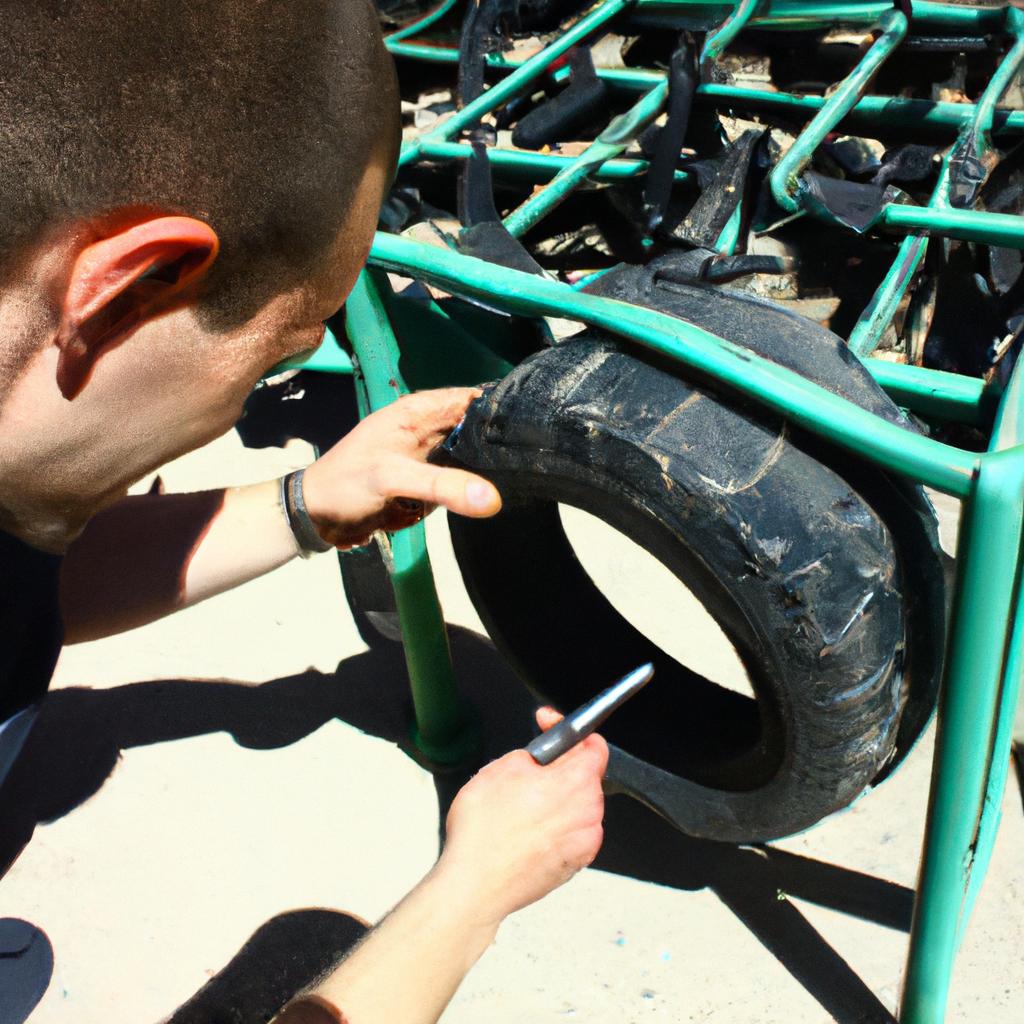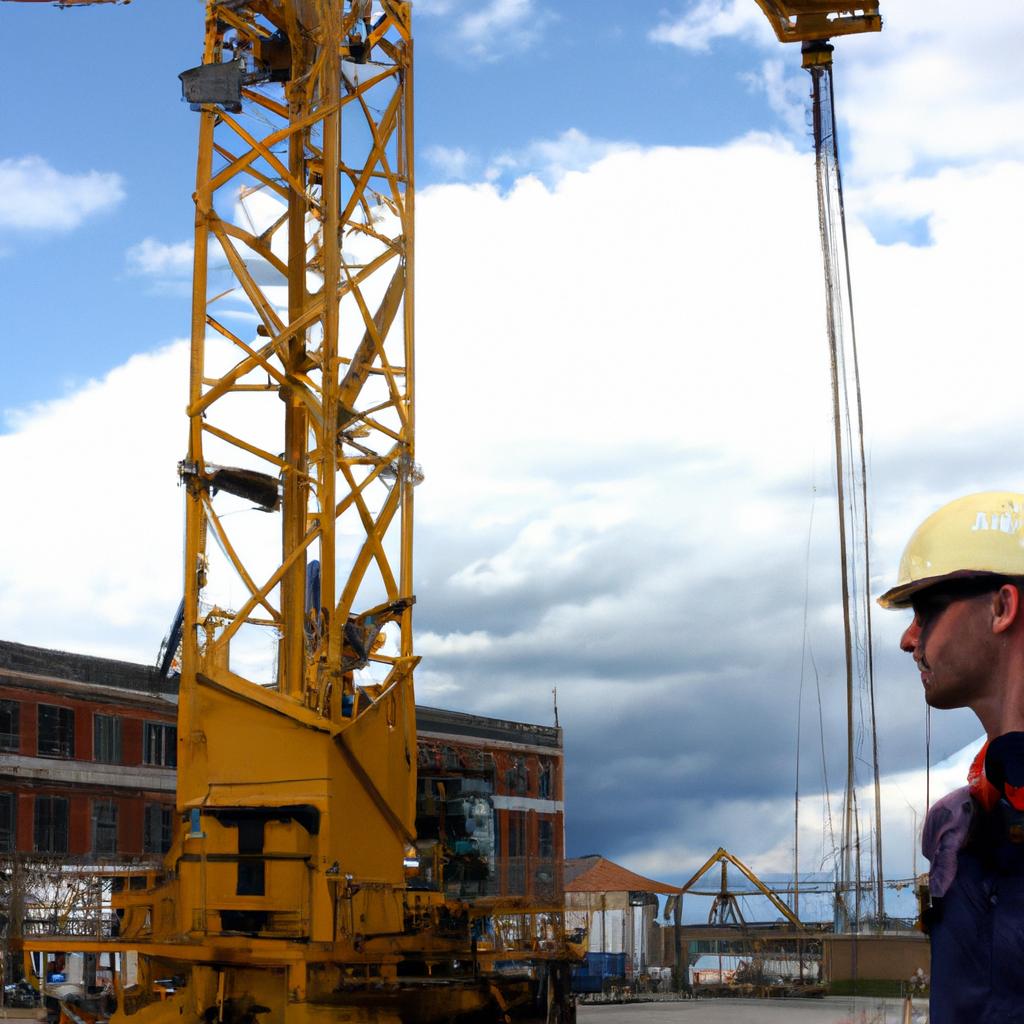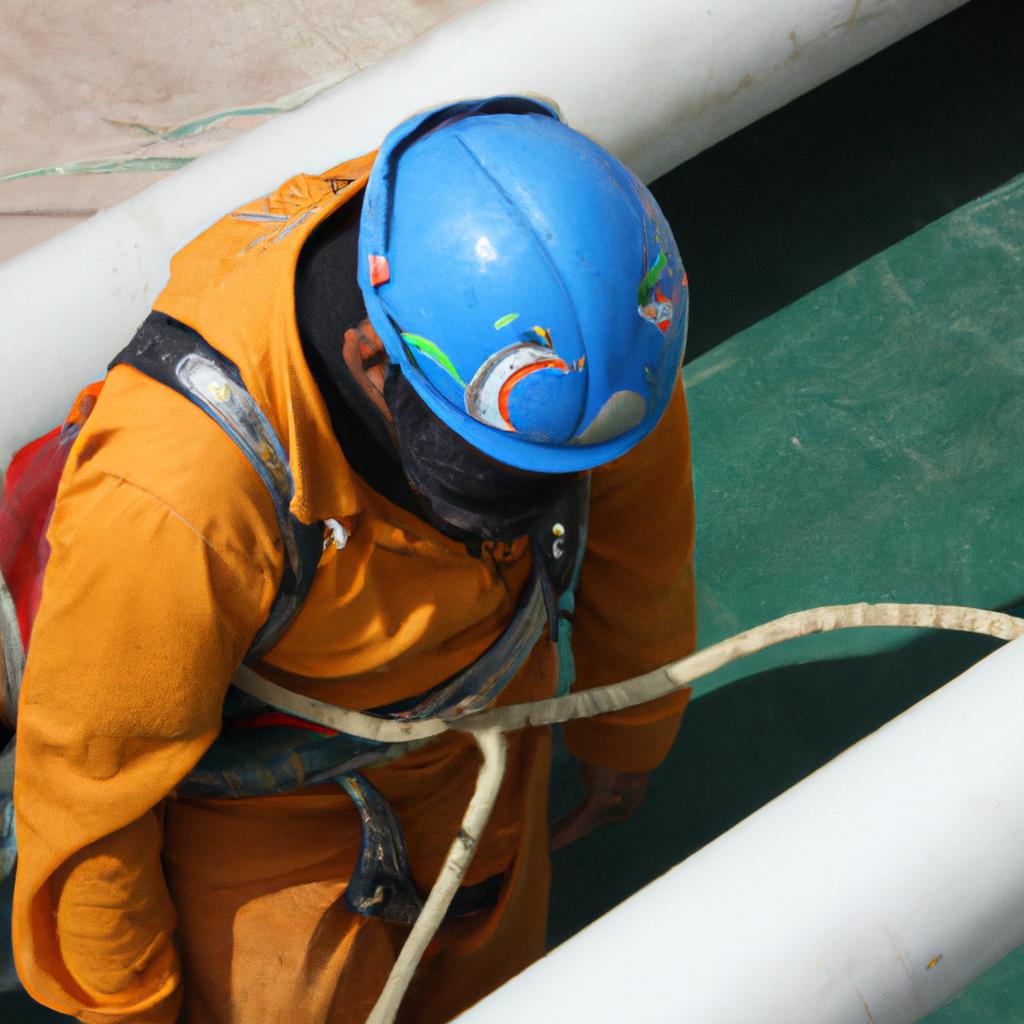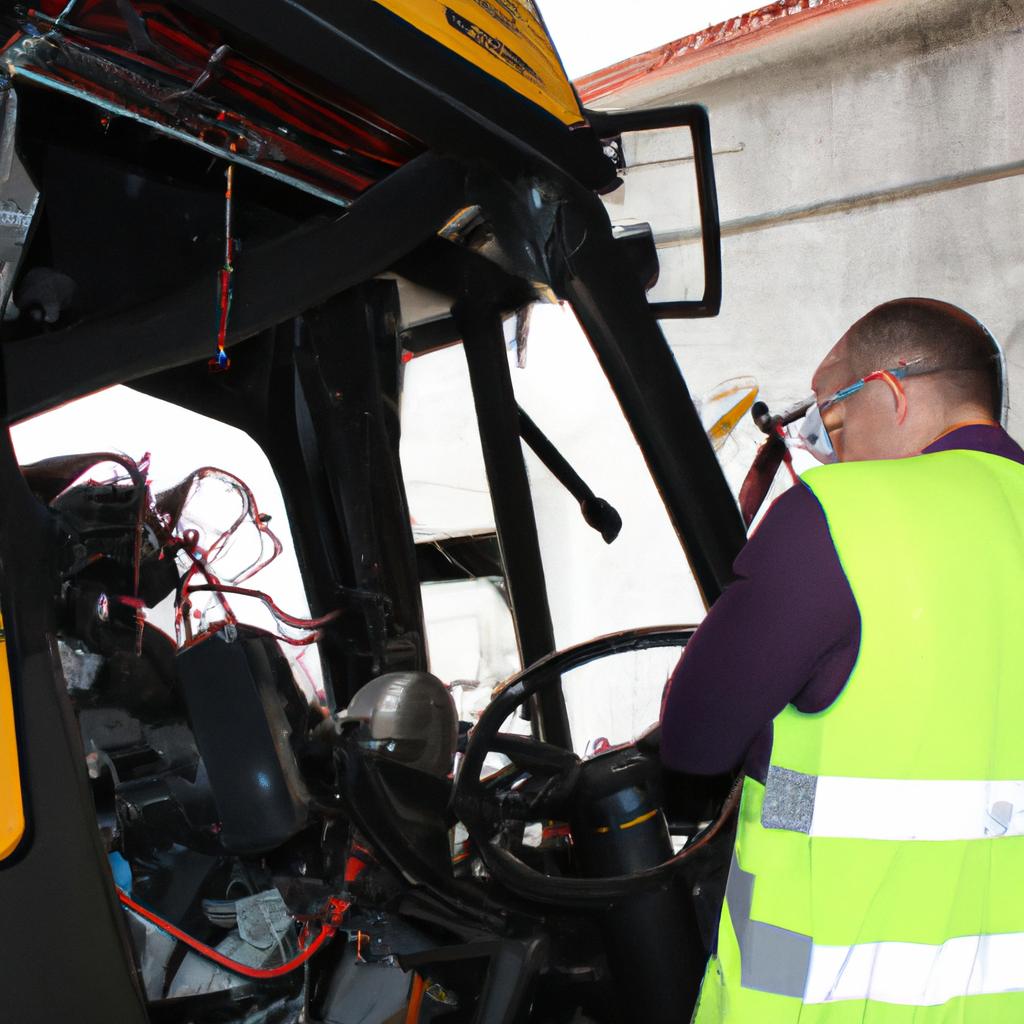The construction and maintenance industry relies heavily on the use of equipment to carry out various tasks efficiently and effectively. From heavy machinery such as excavators and cranes to specialized tools like power drills and surveying instruments, having access to the right equipment is crucial for completing projects on time and within budget. In this comprehensive guide, we will explore the importance of equipment rental in the construction and maintenance sector, providing valuable insights into its benefits and considerations.
Consider a hypothetical scenario where a construction company has been awarded a contract to build a new office complex. The project involves numerous activities, including site preparation, excavation, concrete pouring, plumbing installation, electrical wiring, and interior finishing. To successfully execute these tasks, the company would require an array of different equipment types at different stages of the project. However, purchasing all these machines outright may not be feasible due to high costs, limited storage space, or infrequent usage after completion of the current project. This is where equipment rental becomes invaluable – enabling companies to access a broad range of specialized tools and machinery without significant upfront investment or long-term commitment.
Different types of equipment used in construction and maintenance
Different types of equipment are essential in the construction and maintenance industry. These tools enable workers to efficiently carry out various tasks, ranging from excavation and demolition to painting and plumbing. Understanding the different categories of equipment used in these fields is crucial for professionals seeking to optimize their operations.
One example that highlights the significance of having access to diverse equipment options involves a construction project that requires both heavy machinery and specialized tools. The use of excavators, bulldozers, and cranes would be necessary for tasks such as land clearing, site preparation, and lifting heavy materials. At the same time, more specific tools like concrete mixers, nail guns, or pipe cutters may also be required for activities such as pouring foundations or assembling structures.
In considering the range of equipment available for construction and maintenance purposes, it is helpful to categorize them into four main groups:
-
Earthmoving Equipment: This category includes machinery designed for digging, grading, leveling, hauling, and compacting earth materials. Examples include excavators, loaders, backhoes, graders, and compaction rollers.
-
Material Handling Equipment: As the name indicates, this group involves machines employed in moving materials within job sites. Forklifts, cranes (mobile or tower), hoists, conveyor belts are some examples frequently utilized in large-scale projects.
-
Construction Tools: These are handheld devices that facilitate specific tasks during construction activities. They can range from basic hand tools like hammers and screwdrivers to power tools such as drills or saws.
-
Specialized Equipment: Certain jobs require highly specialized equipment tailored specifically for particular applications – often involving complex engineering principles or high precision requirements. Some examples include surveying instruments used by land surveyors or laser levels utilized during building layout processes.
| Category | Example Equipment |
|---|---|
| Earthmoving Equipment | Excavator |
| Loader | |
| Backhoe | |
| Grader | |
| Material Handling | Forklift |
| Equipment | Crane |
| Hoist | |
| Conveyor Belt | |
| Construction Tools | Hammer |
| Screwdriver | |
| Drill | |
| Specialized Equipment | Surveying Instruments |
| Laser Levels |
Understanding these categories and their respective equipment options is crucial for construction and maintenance professionals. By categorizing them, individuals can identify the specific tools required for each project phase or task. This knowledge enables efficient planning, budgeting, and successful completion of projects.
Transitioning into the subsequent section about “Factors to consider when choosing equipment rental providers,” it is essential to evaluate various factors before making a decision. These considerations encompass aspects such as cost-effectiveness, quality assurance, availability, reliability, and flexibility in terms of rental periods.
Factors to consider when choosing equipment rental providers
Imagine a scenario where a construction company is tasked with building a large-scale infrastructure project. They have various options for equipment rental providers, each offering different types of machinery and services. To illustrate this situation further, let’s consider the hypothetical case study of Company X, which needs to rent equipment for their upcoming road construction project.
When choosing an equipment rental provider, there are several crucial factors that need to be considered. Firstly, it is essential to evaluate the quality and reliability of the machinery offered. In Company X’s case, they require heavy-duty excavators, bulldozers, and asphalt pavers capable of handling rigorous workloads without frequent breakdowns or delays. Additionally, considering the age and condition of the equipment can provide insight into its overall performance and durability.
Secondly, it is important to assess the range of available equipment at each potential rental provider. A diverse selection allows companies like Company X to choose precisely what they need for their specific project requirements. For instance, if Company X determines that compactors are necessary for smoothing out newly laid asphalt roads effectively, they would benefit from having access to those machines through their chosen equipment rental provider.
Furthermore, pricing plays a significant role in selecting an equipment rental provider. The costs associated with renting machinery should align with both budgetary constraints and expected returns on investment. By comparing prices across multiple providers while keeping in mind the desired level of quality and range of equipment required by Company X, informed decisions can be made regarding cost-effectiveness.
Consider these emotional aspects when evaluating your choices:
- Reliability: Ensuring minimal downtime during projects
- Efficiency: Maximizing productivity through advanced technology
- Safety: Providing well-maintained machinery for worker protection
- Environmental Impact: Opting for eco-friendly equipment reduces carbon footprint
| Emotional Aspect | Benefits |
|---|---|
| Reliability | Minimizes project delays and interruptions |
| Efficiency | Increases productivity and project completion speed |
| Safety | Ensures a secure working environment for employees |
| Environmental Impact | Reduces carbon footprint and promotes sustainability |
Understanding the importance of proper equipment selection is crucial for successful construction and maintenance projects. By carefully evaluating factors such as quality, range, and pricing, companies can make informed decisions when choosing their equipment rental provider.
Benefits of renting equipment instead of purchasing
When it comes to selecting equipment rental providers, several factors should be taken into consideration. One key factor is the availability and reliability of the equipment. For example, imagine a construction company that needs a crane for a specific project. If they choose an equipment rental provider that frequently experiences downtime or lacks proper maintenance protocols, it could result in costly delays and disruptions to their operations.
Another essential factor is the range of available equipment options. A reputable rental provider should offer a diverse selection of machinery suitable for different projects and industries. This ensures that clients can find the right equipment tailored to their specific needs, whether it’s heavy machinery for large-scale construction or specialized tools for maintenance tasks.
Furthermore, pricing transparency plays a crucial role in choosing an equipment rental provider. It is important to consider not only the initial cost but also any additional fees associated with renting the equipment. By obtaining detailed quotes and understanding all potential charges upfront, businesses can accurately budget and avoid unexpected financial burdens down the line.
To emphasize these considerations further, here are some bullet points highlighting how making informed choices regarding equipment rental providers can benefit your business:
- Minimize operational downtime by ensuring reliable and well-maintained equipment.
- Increase productivity by having access to a wide range of specialized machinery.
- Optimize budget allocation by understanding all costs involved in renting equipment.
- Enhance project efficiency by partnering with dependable providers who prioritize customer satisfaction.
Additionally, let’s examine this table comparing two hypothetical equipment rental providers based on various criteria:
| Criteria | Provider A | Provider B |
|---|---|---|
| Availability | Limited | Extensive |
| Maintenance | Inconsistent | Regular |
| Pricing Transparency | Unclear | Transparent |
| Customer Satisfaction | Mixed reviews | Positive feedback |
As evident from this comparison, choosing an equipment rental provider with extensive availability, regular maintenance practices, transparent pricing, and positive customer satisfaction can greatly benefit your business.
In the upcoming section on “Key considerations for negotiating rental agreements,” we will explore how to establish mutually beneficial terms when entering into a rental agreement. By understanding these key factors and negotiation strategies, businesses can maximize their value from equipment rentals while minimizing potential risks or complications.
Key considerations for negotiating rental agreements
Benefits of Renting Equipment Instead of Purchasing
In the previous section, we explored the benefits of renting equipment instead of purchasing it outright. Now, let us delve deeper into some key considerations for negotiating rental agreements in the construction and maintenance industry.
Firstly, it is crucial to thoroughly assess your project requirements before entering into a rental agreement. Consider factors such as the duration of the project, specific tasks that require specialized equipment, and any potential fluctuations in demand. For instance, let’s imagine a scenario where a small construction company secures a contract to build a residential complex. They estimate that they will need an excavator for three months to complete the excavation work efficiently. By opting to rent an excavator rather than buying one, they can save on upfront costs and avoid unnecessary expenses once the project concludes.
Secondly, carefully scrutinize the terms and conditions outlined in rental agreements. Ensure that you fully understand all clauses related to liability, insurance coverage, maintenance responsibilities, and late return penalties. By doing so, you can mitigate any potential disputes or unexpected financial burdens down the line. To illustrate this point further:
- Liability: It is essential to clarify who assumes liability for accidents or damages during equipment operation.
- Insurance Coverage: Determine whether your existing insurance policies adequately cover rented equipment or if additional coverage is necessary.
- Maintenance Responsibilities: Understand what level of routine maintenance is expected from renters and how major repairs are handled.
- Late Return Penalties: Familiarize yourself with any fees imposed for exceeding agreed-upon rental durations.
To facilitate better comprehension of these considerations, consider the following overview table:
| Consideration | Description |
|---|---|
| Liability | Clarify responsibility for accidents or damages during equipment operation |
| Insurance Coverage | Assess adequacy of existing insurance policies |
| Maintenance | Determine routine maintenance expectations |
| Late Return Penalties | Understand fees associated with exceeding agreed-upon rental durations |
By taking these considerations into account, you can ensure a smoother and more cost-effective rental experience. In the subsequent section, we will explore the importance of proper maintenance and care for rented equipment, highlighting best practices to maximize its longevity and performance.
Proper maintenance and care of rented equipment is vital in ensuring its optimal functionality throughout your project.
Proper maintenance and care of rented equipment
Having established key considerations for negotiating rental agreements, it is imperative to now shift our focus towards ensuring proper maintenance and care of rented equipment. Failure to do so can lead to costly damages, project delays, and potential safety hazards. To illustrate the importance of this topic, let us consider a hypothetical scenario where a construction company rents heavy machinery without adequately maintaining it.
Example Scenario:
In an attempt to cut costs, Construction Company XYZ decides to rent a crane for their ongoing high-rise building project. The company neglects regular inspections and fails to follow manufacturer-recommended maintenance procedures throughout the rental period. As a result, during operation on a particularly busy day at the site, the crane malfunctions due to neglected wear-and-tear issues. This leads not only to significant downtime but also poses serious risks for both workers and nearby structures.
To ensure smooth operations and minimize unforeseen disruptions caused by inadequate equipment maintenance during rentals, here are some crucial steps that should be followed:
- Regular Inspections: Conduct thorough visual inspections before each use as well as periodic comprehensive inspections carried out by qualified technicians.
- Adherence to Maintenance Schedule: Strictly adhere to the recommended maintenance schedule provided by the equipment supplier or manufacturer.
- Proper Cleaning: Regularly clean all parts of the rented equipment after use with appropriate cleaning agents according to manufacturer guidelines.
- Documented Records: Maintain detailed records of all inspections, repairs, and maintenance performed on rented equipment.
Table: Importance of Proper Equipment Maintenance
| Benefits | Impact | Examples |
|---|---|---|
| Enhanced Safety | Decreased accidents | Periodic inspections |
| Reliable Performance | Minimized downtime | Adhering to maintenance schedules |
| Cost Savings | Avoidance of repair/replacement expenses | Timely cleaning using appropriate agents |
| Legal Compliance | Avoidance of penalties/fines | Documenting all maintenance activities |
By adhering to these best practices, construction and maintenance companies can ensure the longevity and optimal performance of rented equipment. A proactive approach towards maintenance not only safeguards workers’ safety but also minimizes financial implications arising from avoidable damages or breakdowns.
With a clear understanding of proper equipment maintenance, it is essential to explore cost-effective strategies for optimizing equipment rental in construction and maintenance projects. By implementing these strategies, companies can maximize efficiency while effectively managing their resources.
Cost-effective strategies for optimizing equipment rental in construction and maintenance
Section H2: Cost-effective strategies for optimizing equipment rental in construction and maintenance
Building upon the importance of proper maintenance and care, it is crucial for construction and maintenance professionals to employ cost-effective strategies when utilizing rented equipment. By implementing these strategies, businesses can optimize their equipment rental processes and maximize efficiency while minimizing costs.
Example: To illustrate this point, let us consider a hypothetical scenario where a construction company needs to complete a project that requires specialized machinery such as excavators, cranes, and bulldozers. Instead of purchasing these expensive pieces of equipment outright, the company decides to rent them from a reputable supplier.
To ensure cost-effectiveness throughout the rental period, here are some key strategies that can be implemented:
- Efficient scheduling: Proper planning and coordination of equipment usage will help avoid unnecessary downtime or overlapping rentals. This includes creating detailed schedules based on project timelines and requirements.
- Regular maintenance checks: Just as with owned equipment, regular inspections should be conducted to identify any potential issues early on. Timely repairs or replacements can prevent costly breakdowns during critical stages of a project.
- Optimal utilization: Ensuring that the rented equipment is used efficiently helps minimize idle time and maximize its productivity output. Training employees on proper usage techniques can significantly contribute to optimal utilization.
- Negotiating favorable terms: It is essential to negotiate favorable rental rates and contractual agreements with suppliers. This may involve exploring long-term rental options or bundling multiple pieces of equipment together for discounted prices.
By employing these cost-effective strategies, companies can enhance their overall operational performance while keeping expenses under control.
Table (Equipment Rental Cost Comparison):
| Equipment Type | Purchase Price ($) | Monthly Rental Rate ($) |
|---|---|---|
| Excavator | $150,000 | $8,000 |
| Crane | $200,000 | $10,000 |
| Bulldozer | $180,000 | $9,500 |
| Total (3 items) | $530,000 | $27,500 |
Bullet Point List (Advantages of Equipment Rental):
- Flexibility to choose different equipment for specific projects
- Access to the latest technology and models without significant upfront investment
- Reduced maintenance and repair costs as these are typically covered by the rental supplier
- Avoidance of long-term storage expenses when equipment is not in use
In summary, cost-effective strategies play a vital role in optimizing equipment rental processes within the construction and maintenance industry. By efficiently scheduling usage, conducting regular maintenance checks, ensuring optimal utilization, and negotiating favorable terms with suppliers, businesses can enhance their efficiency while minimizing expenses. The advantages offered by equipment rental further contribute to improved operational performance and reduced financial burden.
 Location Benne Gironde
Location Benne Gironde



